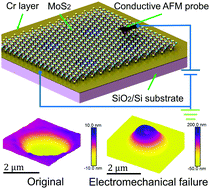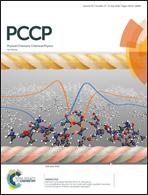Electromechanical failure of MoS2 nanosheets†
Abstract
Molybdenum disulfide (MoS2) has attracted particular attention as a promising electronics and optoelectronics material due to its significant physical properties. In this research, the electromechanical properties of MoS2 nanosheets are systematically investigated with the conductive AFM nanoindentation method. The suspended MoS2 nanosheets with the thickness of tens of nanometers can sustain external applied load (∼4.3 μN) until the bias increases to a critical value (+4 V). Small external load (∼400 nN) may also lead to a failure when the bias (+7 V) overcomes the contact Schottky barrier and generates high electric current. The extent of destruction of MoS2 nanosheets is related to the external applied load and the bias. Besides, the MoS2 nanosheets suspended on the holes are more likely to be damaged than those supported on the substrate under the same conditions. The volcanic volume expansion profiles of the damaged area after the electromechanical failure are caused by electric current-induced local heating anodic oxidation and buckling-induced structural instability. The emergence of gas bubbles in the damaged area proves the strong oxidation process. These experiments have proved that the electric current can promote the mechanical failure of MoS2 nanosheets. The findings can also provide beneficial guidance for the electromechanical applications of MoS2 nano-devices.



 Please wait while we load your content...
Please wait while we load your content...